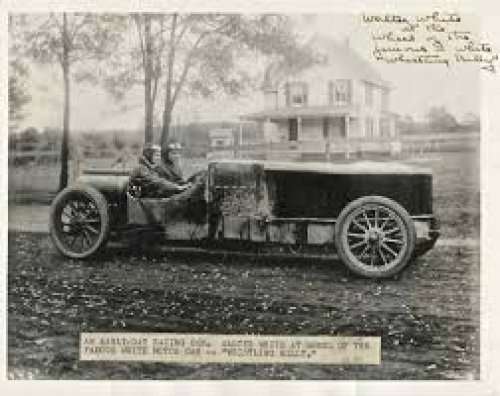Saturday 27th May 1905
White’s ‘Whistling Billy’ steam car made its racing debut, with Webb Jay winning the opening 10-mile race at Chicago’s Harlem Racetrack. Arguably the most famous steam car ever produced, ‘Whistling Billy’ was one of the fastest cars of the American dirt track races in the early 20th century, before being all but destroyed in a crash in 1912 and left to rust on an American farm. Whistling Billy was engineered specifically for racing. It originally featured a compound 18hp White steam car engine with Stephenson’s link motion, but it was soon modified to include a piston valve instead of a slide valve on the high pressure side. This highly successful modification influenced the design of further White cars and from 1907, all their engines had this feature. The steam pressure was 800psi – twice that of the touring cars of the time – with a temperature of 750 degrees Fahrenheit, making the steam pipes red hot. Originally known as the ‘White Rocket’, the car was lovingly renamed ‘Whistling Billy’ by the crowds who watched it race due to the howling noise that came from its burners as it went down the straights. It won numerous races in its early years and in 1905, it shaved nearly 4 seconds off the world track record for the mile on a dirt round track with a time of 48.45 seconds. The driver at the time, Webb Jay, believed he was driving the fastest car in the world, but his racing career would soon come to an end when six weeks later, he crashed Whistling Billy into a pond and was seriously injured. Against the odds Jay survived, but the White Sewing Machine Company deemed racing to be too dangerous and withdrew its interests from motorsport, reducing the car to nothing more than an exhibit and putting Whistling Billy on display in their Chicago branch. In 1907, Charlie Bair, a wealthy sheep farmer, persuaded White to rebuild Whistling Billy and sell it to him in a $20,000 deal – eight times the cost of an average steam tourer at the time. Bair proceeded to enter the car into the dirt track races once again, where the car was highly successful. It won the Kansas Post Chase in 1907 and in 1908, broke the five mile world track record at the event, earning the owner $50,000 in prize money. However, in 1908, during a race at Ascot Park in Los Angeles, a front tyre blew out on a curve and the car flipped over three times in the air landing in the middle of the track where it was almost destroyed by fire. But Bair refused to let the car go and had it rebuilt in 1909 with a new 18hp double piston-valve engine with Joy valve gear. The car became 18 inches shorter and 400lbs lighter than before, although many parts were likely reused. Despite being officially renamed as the ‘White Flyer’, the car was still known as Whistling Billy by the public, and went on a successful tour across the west coast of the USA, winning all of its 29 races that year. After a string of near misses, 1912 would eventually prove to be the end for Whistling Billy. During a practice run in Portland, Oregon, the car crashed over an embankment and was found upside down, broken in half. The driver, Chris Dundee, was seriously injured, but survived. Following the crash, the car was said to have ended up in storage at Charlie Bair’s solicitor’s premises, before being moved onto a farm, with the engine being put into a boat. – See more at: http://www.chateauimpneyhillclimb.com/blog/whistling-billy-steam-car-bob-dyke/#sthash.md4Uql70.dpuf






